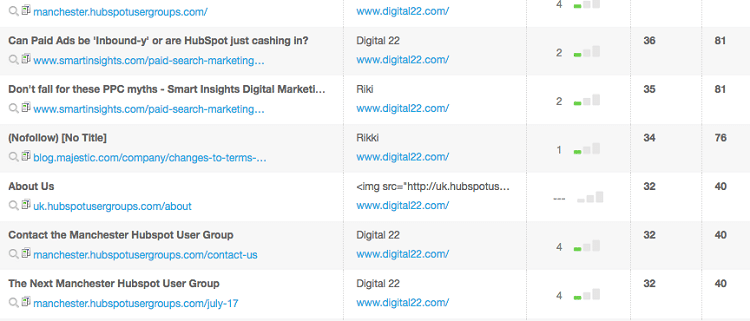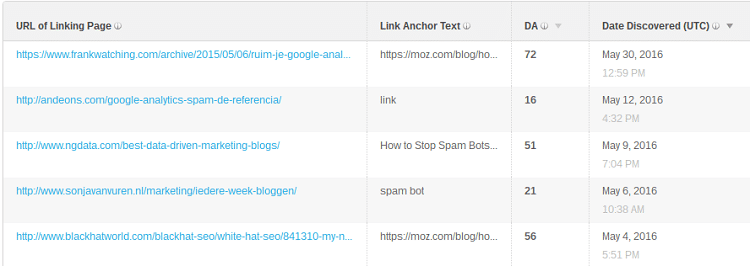When I went to BrightonSEO last year, some of the speakers said link building wasn’t important anymore.
They said it was not a significant ranking factor and we should be focusing our attention on other factors.
However, other speakers (and I agree too,) believe link building continues to play a crucial part in SEO.
In this post, you will learn why I think second-tier links are important.
I’ll show you some examples and tell you how you can get more secondary links to improve your rankings and your traffic.
Wait a minute, what are second-tier links exactly?
From experience chatting to SEOs, talking about first-, second-, and third-tier links can sometimes bring up some confusion.
While you may not be able to describe what these different type of tier links are, you’ve probably been using them already.
First-tier links are website links that directly link to your website.
For example: If you’re writing a guest post on behalf of your company, the links you include in the content that link directly to your website will be first tier.
The image below shows links we have achieved through writing guest posts and being mentioned on a site. This data is found through Moz.
Second-tier links are links that are directed to your guest blog that contains links to your website.
For example: You share a social media message linking to your guest post that links to your website.
The social message link is a second-tier link. When other websites are linking to your guest blog, these links are examples of second tiers, too.
Some SEOs don’t like spending time on second-tier links because they think these links don’t offer any ranking benefits.
But if they’re sending traffic to your guest post, and people are then clicking on your website link in the author bio, you’re getting valuable traffic to your site.
Regular traffic is considered an important ranking feature.
Second tier links are still important and this is why…
More authority
When you’ve written a guest blog for another site, you can receive some ranking benefits of being associated with a higher domain authority site.
But it doesn’t just stop there. If other high domain authority sites are linking to your guest blog, you’re then getting the benefits, too.
Just because they aren’t first-tier links doesn’t mean they aren’t valuable.
Helpful tip: Discovering you’ve got high authority websites linking to your site is a good “conversation starter” when asking to write a guest blog for a high DA site.
If you know a high domain authority website has linked to your guest blog, it’s clear they like what you’ve talked about before.
You can mention you’ve seen they have linked to your work, and you can ask if they are interested in getting an article from you on their site.
More referral traffic
It doesn’t matter if the link on your guest post is a nofollow link because it doesn’t stop referral traffic from visiting your website.
Second-tier links give you the opportunity to get even more readers to see your guest post, and hopefully visit your website/blog, too.
More relevance
Second-tier links automatically link you to other sites.
The website you’ve written a guest post for will already have relevance to your site (that’s why you chose to write for it, in the first place), and the other sites linking to your guest post will very likely be relevant to your topic, too.
When talking about ranking factors, Google has said relevance is crucial.
Being relevant with keywords and link building helps the search engine understand what your site is about.
When your website is associated with more sites in your particular niche/industry, it helps Google pinpoint where it belongs.
More customers
Potential customers and readers will be able to find your site with secondary links.
When other sites link to your guest content, it’s highly likely they have an interest in your industry.
People from those sites will see your guest post, and there is a chance they will visit your site, too.
And most importantly, the people who are coming from these second-tier sites are using relevant keywords and are your ideal customers.
They are ideal visitors because they are already interested in the subject niche and have taken the time to visit your site for more of your knowledge and products.
Therefore, very valuable contacts to have.
Secondary tier links in action
I’ve collected some examples to show second-tier links in action.
This blog on Moz.com is a guest blog entitled “How to Stop Spam Bots from Ruining Your Analytics Referral Data” by Jared Gardner.
In the bio at the bottom of the guest post is information about Jared and a link to his website, Red Door Interactive.
In the profile bio, there is a link to the writer’s website.
To see second-tier linking in action, I researched how many links are linking to Jared’s guest post.
Using Moz’s link tool Open Site Explorer, I can see how many and what types of referral links there are.
In the Page Link Metrics section, there are 50 root domains linking to this guest post.
That means there are 50 websites potentially bringing readers to this blog, and it’s likely they will visit the author’s website, too, particularly if what the author wrote resonates with those readers.
Through Moz.com, the author has written for a popular and highly regarded site in his industry.
The 50 sites that are linking to this blog will likely bring high-quality traffic, too.
Another benefit of second-tier link building is the opportunities continue to grow long after you’ve written a guest post. Just last month, 5 new sites linked to this guest post, providing 5 additional routes for relevant readers to find it.
These websites are bringing relevant people in your niche to your guest post and giving them the chance to find your website.
This shows second-tier links in action.
How to increase your second-tier link building
From what we’ve just covered, it’s clear that links from secondary sites offer many benefits.
But how do you increase the number of second-tier links to your site?
Do social sharing
Promote the guest blogs you’ve written on social networking sites. As soon as your article is live, you should be promoting it to your networks anyway.
Just because you’re sending traffic to another person’s site doesn’t mean you’re not getting the benefits, too.
These secondary links from social sharing will bring interested readers to your content.
Helpful tip: To get the best out of social sharing, make sure you’re posting on social platforms that are relevant to your ideal readership.
Make sure the site owner you’ve written the content for does their own social sharing because it’s likely they have a different following to yours.
Encourage them to retweet or share your social posts. After all, you’re promoting their site.
The more publicity the site owner receives from social networks, the more readers who will read your guest blog and likely visit your site, too.
Reach out to relevant sites
Be selective with the sites you want to write for.
Before you send an outreach email, spend some time going through the prospective website.
Do they have the same type of readership as yours?
Do they discuss similar topics that you have on your site?
While second-tier links are important, you want links that will bring in relevant traffic.
You want people reading your guest content and then visiting your site.
They will only do that if they are genuinely interested in what you’re talking about.
Do PR
PR campaigns are perfect opportunities to promote your business and to get secondary links.
Get newspapers and magazines to write about you (or your business).
These articles will be read by interested readers, and if they link to these PR sources, they will instantly become second tier.
It’s important to contact newspapers and magazines that are relevant to your industry.
This way, you’ll likely get more people who are interested in your business and what you have to say.
And if they like the sound of your business (or you), they will promote the newspaper article on their social networks or even on their own sites, creating more secondary links.
The importance of secondary link building
While you might automatically want to focus your outreach time on creating first tier-links, you shouldn’t completely ignore the opportunities of secondary links.
In SEO discussions, the topic of link building is always brought up. Some people think it’s not important anymore, but it’s clear it is still relevant and shouldn’t be disregarded.
Link building is still a ranking factor but you must follow Google’s guidelines to avoid harmful penalties.
Along with link building, there are many other SEO ranking factors, and it’s important to use different strategies to improve your site’s overall rankings.
Other factors to consider are Page Authority, anchor text, uniqueness of page content, and many more.
To help with your SEO efforts, it’s worth reviewing all these ranking factors to see how easy they are to implement and if you have the resource to carry them through.
Make a list of the most important, the factors that will make the most difference to your efforts and get to work!
Next time you’re planning your outreach campaign, consider how you will approach secondary link building.
If you’re creating helpful and relevant content, you will automatically see an increase in second-tier links because most people like to share information they think is helpful.
Rikki is the director at Digital 22. He is an inbound marketer with over 8 years experience and has qualifications from Hubspot, Google, Bing and The Chartered Institute of Marketing.
The post The Incredible Benefits Of Second Tier Links For Your SEO appeared first on Ninja Outreach.
source https://ninjaoutreach.com/second-tier-link-seo/




No comments:
Post a Comment